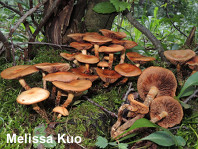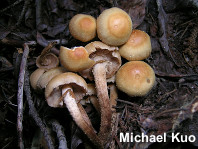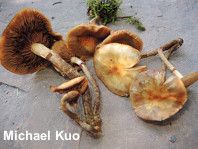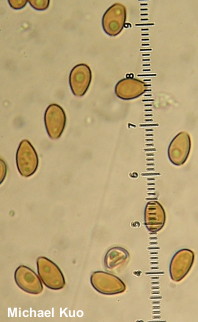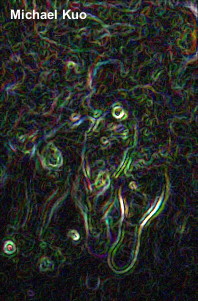| Major Groups > Gilled Mushrooms > Dark-Spored > Pholiota > Kuehneromyces mutabilis |

|
Kuehneromyces mutabilis [ Basidiomycota > Agaricales > Strophariaceae > Kuehneromyces . . . ] by Michael Kuo Among the 200 or so pholiotoid mushrooms that have been described for North America, Kuehneromyces mutabilis is fairly distinct. It has a bald, "hygrophanous" cap—meaning it changes color markedly as it dries out, going from orangish brown to yellowish, often passing through a two-toned stage. The stem is scaly, and usually features a well developed ring. Like other pholiotoid mushrooms it grows on wood, has a brown spore print, and features gills that are attached to the stem. Identifying microscopic features include the small spores with a well developed pore, and small cheilocystidia. Similar mushrooms include Galerina marginata, with a stem that is not scaly and a cap that turns red with KOH; Hypholoma capnoides, with a smooth stem and gills that become grayish brown to purplish brown; and several species of Armillaria, with white spore prints—especially Armillaria nabsnona, which grows on the wood of alders (I have found Kuehneromyces mutabilis on alder wood and on conifer wood). Although Kuehneromyces mutabilis is frequently treated as a species of Pholiota, DNA studies that have included the species (e.g. Matsumoto et al. 2003, Jacobsson & Larsson, 2007) support the idea that it belongs apart from Pholiota in Kuehneromyces, which was established by Singer & Smith (1946) with Kuehneromyces mutabilis as the representative, or "type," species. Pholiota mutabilis and Galerina mutabilis are synonyms. Description: Ecology: Saprobic; growing in clusters (rarely growing alone) on the wood of hardwoods or conifers; spring, summer, and fall (and over winter in warm climates); widely distributed and common in montane western North America, and occasionally reported from the Appalachian Mountains. The illustrated and described collections are from Colorado. Cap: 3–5.5 cm; convex, becoming broadly convex or nearly flat; sticky when fresh; bald or, when young, with scattered whitish to yellowish fibrils; tawny to orangish brown, changing color markedly as it dries out and fading to yellowish or brownish (often passing through a two-toned stage); the margin finely lined when moist. Gills: Attached to the stem by means of a notch; close; short-gills frequent; whitish to pale tan when young, becoming cinnamon brown; at first covered by a whitish to pale tan partial veil. Stem: 5–9 cm long; up to 1 cm thick; tapered to the base; dry; silky near the apex; with a fairly persistent whitish ring that features an orangish brownish edge and eventually becomes orangish brown overall--or with merely a ring zone; whitish becoming brown from the base up; covered with small, whitish to brownish scales. Flesh: Whitish; unchanging when sliced. Odor and Taste: Not distinctive. Chemical Reactions: KOH negative on cap surface. Spore Print: Cinnamon brown. Microscopic Features: Spores 6–8 x 4–5 µm; subellipsoid to sublacrymoid; with a well developed apical pore; smooth; pale brown to brownish golden in KOH. Cheilocystidia 35–50 x 7.5–12.5 µm; lageniform with a long neck and a subcapitate to subclavate apex; thin-walled; smooth; hyaline in KOH. Pleurocystidia not found. Pileipellis an ixotrichoderm; elements 2.5–7.5 µm wide, smooth, hyaline to brownish or golden in KOH. Clamp connections present. REFERENCES: (Schaeffer, 1774) Singer & A. H. Smith, 1946. (Fries, 1821; Saccardo, 1887; Overholts, 1927; Smith & Hesler, 1968; Smith, 1975; Smith, Smith & Weber, 1979; Arora, 1986; Jacobsson, 1989; Phillips, 1991/2005; Lincoff, 1992; Barron, 1999; Matsumoto et al. 2003; Roody, 2003; Miller & Miller, 2006; Jacobsson & Larsson, 2007; Kuo & Methven, 2014.) Herb. Kuo 08150713, 08131502. This site contains no information about the edibility or toxicity of mushrooms. |
© MushroomExpert.Com |
|
Cite this page as: Kuo, M. (2017, January). Kuehneromyces mutabilis. Retrieved from the MushroomExpert.Com Web site: http://www.mushroomexpert.com/kuehneromyces_mutabilis.html |
